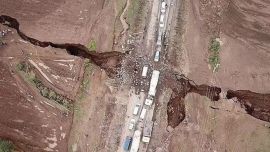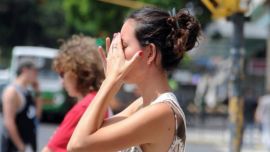The traditional Easter themes are being revived in new forms in this ongoing coronavirus pandemic with today’s Easter Vigil evoking the need for increased vigilance against a gathering second wave while sacrifice has been anything but voluntary over the past year. As if all this were not enough, probably the main news item of an abbreviated week was INDEC statistics bureau’s grim estimate of almost 20 million Argentines below the poverty line with the figure rising to 42 percent last year.
Perhaps the analysis should begin with that percentage, which aroused some scepticism in certain quarters suspecting that a rise of just over five percentage points last year does not do justice to the devastating dimensions of this coronavirus crisis. Here it should be clarified that 42 percent is the average over the entire year of 2020 starting normally enough and that the 45.2 percent posted for its last quarter (which is actually higher than the 44.2 percent calculated by the prestigious UCA Catholic University’s Social Debt Observatory at the close of the year) is the real figure to watch. Three months of uneven economic recovery this year have gone by since then but poverty undoubtedly remains above that 42 percent figure, probably not less than 43 percent.
Any rigorous analysis needs to break down that global figure not only into quarters but also into regions and age groups to appreciate the full impact. Here by far the most worrying figure is that 57.7 percent of those below the age of 15 (or some 6.3 million children) are also below the poverty line, a bleak outlook only compounded by the consideration that an entire year of schooling was lost in 2020 for youngsters facing an increasingly digital future. The INDEC figures invite the deepest pessimism for the future because they indicate that over 40 percent poverty now will be almost 60 percent before mid-century and perhaps 80 percent a generation further down the road, especially given the higher birth rates among low-income groups. Such linear projections are rarely borne out by history but that appalling child poverty figure alone seems to kill any hopes of a brighter future amid our troubled present.
This relentlessly surging poverty worries all of us and naturally worries the government too – or does it? Regional breakdown of the INDEC figures will show us that Greater Buenos Aires is the only zone in the country (apart from the Chaco provincial capital of Resistencia) where the impoverished are not merely a massive minority but already the majority at 51 percent. If the government grip on the Peronist stronghold of Greater Buenos Aires is confirmed in the upcoming midterms as the key to an overall triumph, then the ruling coalition might very well reach the conclusion that there is a direct correlation between rising poverty and electoral success, thus making a “the worse, the better” style of governance the clearest road to power. Let us hope that they do not succumb to this temptation and nor is there any certainty that they will but the temptation is definitely there.
How sadly ironic that for generations the wretched of the backward hinterland have flocked to Greater Buenos Aires only for the worst poverty now to be there. Due to the private sector being far more punished by lockdown than the public, the comparisons between provinces may well have altered drastically, breaking the pattern of the rich becoming richer and the poor poorer – thus a backwater like Formosa whose provincial employee majority is paid on time with a 42 percent increase this year might well have felt the pinch less than more developed provinces where many companies are down and out.
The long-range picture is daunting but the short-term prospects are hardly better. A rebound of up to seven percent growth from last year’s double-digit (OK, 9.9 percent) shrinkage is unlikely to be accompanied by investment and job creation, thus dimming the chances of pushing poverty back below 40 percent. If the percentage below the poverty line almost quadruples the unemployed, that says a lot about the quality of jobs now starting to return.
Poverty should top the political agenda immediately. The government often acts as if the Justice Ministry were its most important portfolio while the opposition, crippled by its own dismal failure to achieve “zero poverty,” maintains an embarrassed silence on this issue, preferring the institutional high ground. But this Easter the greatest urgency must surely be to resurrect almost 20 million Argentines below the poverty line.






















Comments